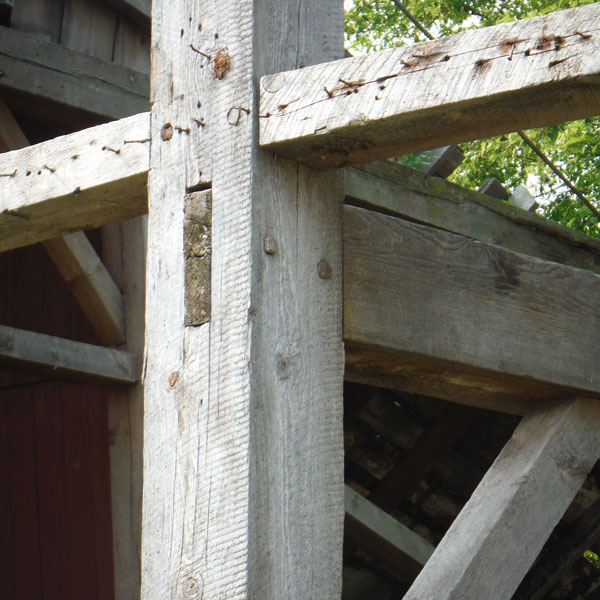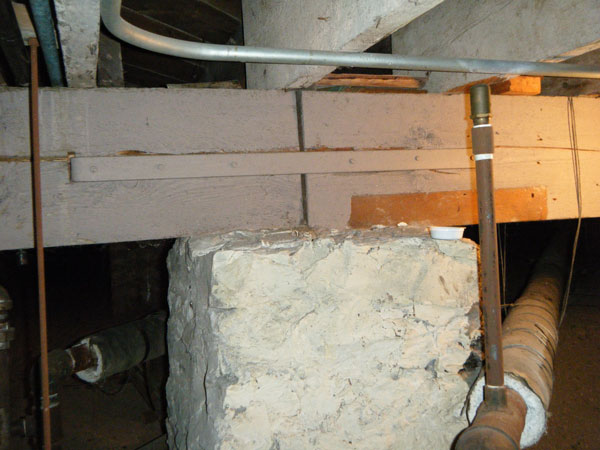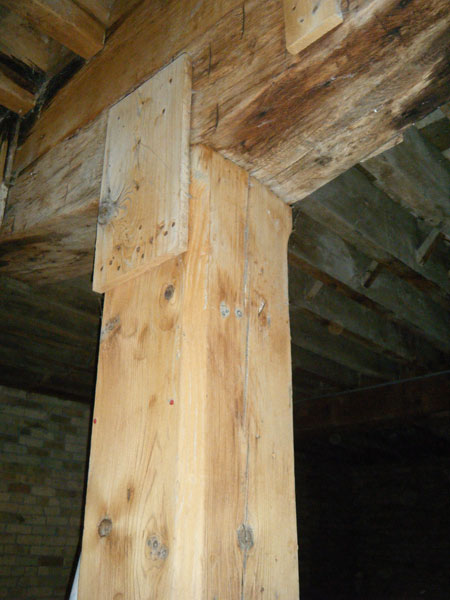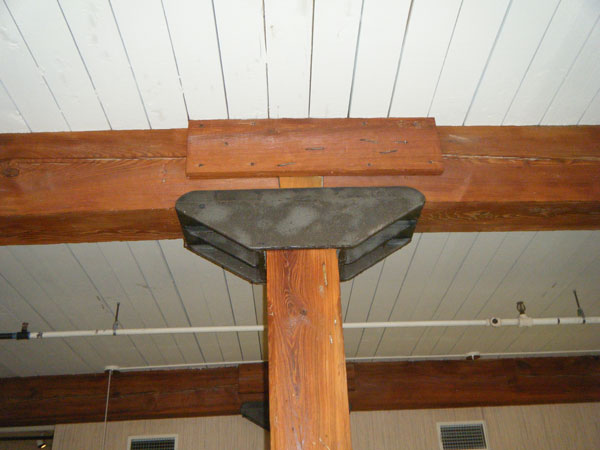
By Gregory Havel
It has been stated many times that the connections in load-bearing structural supports are the weak points in a building. This is especially true if the structural system is old or poorly maintained. These connections are particularly susceptible to failure when exposed to fire, overloaded by building contents, or stressed by natural forces like wind, heavy snow, or earthquakes.

Photo 1 shows three mortise and tenon joints in a post and frame (post and beam) barn built around 1880. In the center of the photo, the tenon on the end of a beam is set in the mortise in a column. The joint is pinned by wood dowels called “tree nails” or “trunnels”. Mortise and tenon joints were made with hand tools by craftsmen, and were fit precisely. Natural shrinkage of the wood as it aged and dried, and the pressure of the wind trying to make the structure sway, has loosened the joint over time. In this photo, rot from exposure to moisture does not seem to be an issue. At the top of the photo are two smaller mortise and tenon joints with trunnels connecting girts to the column. Also visible on the girt are the nails that held the vertical siding boards. While the siding boards became weathered and rotten, they still protected the barn frame from the weather.

Photo 2 shows a view of a crawlspace under a heavy-timber church built around 1895. In the photo, a masonry pier supports the ends of two beams that butt together and support floor joists and a tongue-and-groove plank floor. These are considered “gravity connections,” since there are no connections other than gravity and friction holding the beam to the pier or the joists to the beam. On top of the pier, the butted ends of the two beams are held in alignment by a pair of “dog irons”. These flat strips of wrought iron or steel have a 90-degree bend at each end that is mortised into the beams. The dog irons are held in place by lag screws into the beams. Dog irons were usually installed in pairs, one on each of the opposite sides of the beam butt joint.

Photo 3 shows a beam and a column in a mill construction (heavy timber, Type IV) building constructed in the early 1840s in southeastern Wisconsin. Although this was 40 years before the National Board of Fire Underwriters published their specification for mill construction, it incorporated several of the features that would become code requirements. The column has chamfered corners to eliminate the square corners that are more easily ignited due to their relatively thin cross-section. The wooden girder is carried by a hand-hewn wooden saddle on top of the column. The joint between the column and the saddle has a piece of plank nailed to it, to preserve the integrity of this joint as long as possible if there is a fire. The ceiling of the room is the underside of the tongue-and-groove plank floor above, supported by wood joists; eliminating concealed spaces.

Photo 4 shows the end of the girder at a load-bearing masonry wall, where it is carried by an iron plate set on a brick corbel. This increased the bearing area of the beam on the masonry, while allowing its ends to be fire-cut so that it could release without tipping the wall if there were a fire.

Photo 5 shows a column and beam in a mill construction building constructed in the early 1880s, following the National Board of Fire Underwriters specification for this type of building. The column has chamfered corners. The wooden beam is carried by a cast-iron saddle on top of the column, which protects the joint between the column and beam, and distributes the load. The joint between the ends of butted beams is covered with a piece of plank. The automatic fire sprinkler pipe in the background is original equipment required by the NBFU specification, although the pipe hangers have been replaced, and the sprinkler heads changed periodically according to the schedule in National Fire Protection Association Standard 13, Standard for the Installation of Sprinkler Systems.
Age alone does not condemn a building. All of these buildings were well-maintained and protected from the weather, so the timber framing inside is still in good condition, after 120-170 years. The barn’s status is uncertain at this time, and exposure to weather during decision making will not improve its condition. The church is still in use as a church. Both of the mill buildings are still in use today, the 1840s building for retail sales, and the 1880s building for manufacturing household appliances.
Download this article as a PDF HERE (664 KB).
 Gregory Havel is a member of the Town of Burlington (WI) Fire Department; retired deputy chief and training officer; and a 35-year veteran of the fire service. He is a Wisconsin-certified fire instructor II, fire officer II, and fire inspector; an adjunct instructor in fire service programs at Gateway Technical College; and safety director for Scherrer Construction Co., Inc. Havel has a bachelor’s degree from St. Norbert College; has more than 35 years of experience in facilities management and building construction; and has presented classes at FDIC.
Gregory Havel is a member of the Town of Burlington (WI) Fire Department; retired deputy chief and training officer; and a 35-year veteran of the fire service. He is a Wisconsin-certified fire instructor II, fire officer II, and fire inspector; an adjunct instructor in fire service programs at Gateway Technical College; and safety director for Scherrer Construction Co., Inc. Havel has a bachelor’s degree from St. Norbert College; has more than 35 years of experience in facilities management and building construction; and has presented classes at FDIC.
MORE CONSTRUCTION CONCERNS

